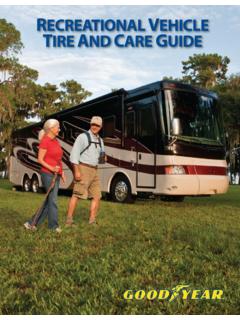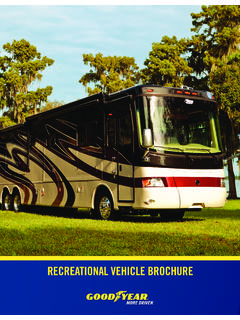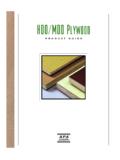Transcription of RECREATIONAL VEHICLE TIRE AND CARE GUIDE
1 RECREATIONAL VEHICLE TIRE AND care GUIDET able of ConTenTsIntroduction to Goodyear RV Tires ..3 Why Choose Goodyear?..4 Four Great Tires To Keep You Rolling ..4 The Big Four of RV Tire care ..5 Tire Inflation ..5 When To Check Your RV or Trailer Tire Pressure ..5 How To Check Your Tire Pressure ..5 The Effects of Temperature and Atmospheric Pressure ..6 How Much Air is Enough ..6 Understanding Gross VEHICLE Weight and Gross VEHICLE Weight Ratings ..6 Weighing Your VEHICLE ..6-9 Load/Inflation Information ..9-11 Proper Load Distribution ..11 Tire and Wheel Maintenance ..12 Tire Rotation Patterns ..12 Wheel Alignment ..12RV Tire care ..13 Routine Tire Inspections ..13 Storing Your VEHICLE Properly ..13 Cleaning Your RV Tires ..14 Removal Conditions ..14 Tire Sizing ..15 Tire Specifications (G670 RV, G614 RST, Wrangler SilentArmor, Marathon) ..16-18 Goodyear Warranties.
2 19-22 Service and Assistance ..22 Notes ..232 Ready to write your next adventure? Goodyear tires can help you Get there !For millions of free-wheeling recreation seekers each year, the adventure of a lifetime is just around the next corner. And as many of them have already found out, when they ride on Goodyear tires, they ride with greater manufactures tires for virtually every RV. Our accumulated experience in engineering and product development is applied to every product we manufacture. So when you hit the road, you have quality performance from your invite you to use this brochure to find a great selection of tires and valuable maintenance tips for your RV, pick-up, fifth-wheel or trailer. For further information, you can also visit RV TIRes3 GoodyeaR TIResWhy choose Goodyear? Goodyear features four premium tire lines for camping enthusiasts. These innovative tires have been optimized for on-/off-road conditions required for camping.
3 From SilentArmor Technology to enhanced compounds and highly engineered designs, these tires will help you Get there .four great tires to keep you rolling. G670 RV for drivers Who demand first-Class Tire Performance for Their Motor Homes Advanced technology helps deliver enhanced traction and treadwear Compounding helps tires resist weather cracking Premium Warranty offers peace of mind (See page 19 for complete details)G614 RsT even Wear In demanding 5th-Wheel and Heavy-Trailer applications Advanced tread compounding promotes even wear Highly engineered design carries heavier loads Grooved treads help deliver superb tractionWrangler silentarmor Rugged Toughness With a smooth, Quite Ride for Pick-Ups DuPont Kevlar belt enhances toughness and helps soak up noise for a smooth, quiet ride Durawall Technology helps resist cuts and punctures in the sidewall Aggressive tread pattern helps deliver traction in off-road conditionsMarathon Versatile.
4 High-Mileage Trailer and Pop-Up Camper Tire Compounding helps tires resist weather cracking Scuff guards help resist sidewall damage from curbing Tread built for high mileageDuPont and Kevlar are trademarks or registered trademarks DuPont de Nemours and pages 16 18 for tire size and wheel InflaTIon PRessUReThe big five of RV tire is calling and you don t want to miss a minute of it! In the pages ahead, you ll find suggestions on how to take care of your Goodyear tires so that you can count on many miles of consistent help make regular tire maintenance and service simple, here are five key areas:1. Regularly inspect your tires for Keep your tires properly inflated in order to maximize Make sure your Gross VEHICLE Weight does not exceed the Gross VEHICLE Weight Make sure the load on your tires is evenly Have your tire and wheel maintenance performed InflaTIonImproper tire inflation can cause problems for tires.
5 Underinflating your tires can cause poor handling, fast and/or irregular wear, decreased fuel economy and permanent structural damage to the tire. Overinflating can reduce traction, braking ability and handling, as well as result in uneven wear and an uncomfortable ride. Also note, checking all tires is necessary. While dual mounted tires are difficult to check, the inside tire must be properly maintained as much as the outside tires so loads are properly distributed and the integrity andperformance of both tires are to check your RV or trailer tire pressure: Before and after storing your VEHICLE On long trips, every morning On short trips, before you leave and when you return home At least once per month while the VEHICLE is in storageHow to check your tire pressure: Tire pressure should be checked when your tires are cold and haven t been driven more than one mile.
6 The load capacity for a given cold inflation pressure is based on ambient outside temperatures. The pressure in a hot tire may be as much as 10 to 15 psi higher than the cold tire pressure. That means you ll only get an accurate reading when you check your tires when they re cold. To ensure your tire pressure readings are accurate, Goodyear recommends that you use a quality truck tire gauge with a dual-angled head. This way, you can check inner and outer dual wheels at the same time. Do NOT bleed air from hot tires. Inflation pressure should be adjusted to the tire carrying the heaviest load, and all tires on the axle should have the same inflation pressure. Use proper sealing metal valve caps or quality flow-through valve caps. Tires that have lost more than 20% of their recommended inflation pressure should be considered flat.
7 Flat tires should be professionally inspected and repaired or replaced by a Goodyear THe ReCReaTIon VeHICleThe effects of temperature and atmospheric temperature and atmospheric pressure effect tire inflation pressure. If the outside temperature increases 10oF, tire inflation pressure increases approximately 2%. Conversely, when the outside temperature drops 10oF, the tire inflation pressure lowers approximately 2%. Tire inflation pressure increases approximately .48 psi for every 1,000 feet of altitude due to changes in atmospheric pressure. On the other hand, tire inflation pressure will decrease approximately .48 psi for every 1,000-foot decrease in other words, if there are changes in temperature or altitude during your trip, it s important to check your tire inflation more much air is enough?The proper air inflation for your tires depends on how much your fully loaded RV or trailer weighs.
8 Look at the sidewall of your RV tire and you ll see the maximum load capacity for the tire size and load rating, as well as the minimum cold air inflation, needed to carry that maximum load. (See load inflation charts on pages 9 11.) UndeRsTandInG GRoss VEHICLE WeIGHT and GRoss VEHICLE WeIGHT RaTInGsHow to weigh your RV or trailer to determine proper tire get an accurate weight, your RV or trailer must be fully loaded with the items you re taking on your trip, including food, clothing, water, fuel, pets, supplies, people, towed vehicles or other items. This will give you the VEHICLE s Gross VEHICLE Weight (GVW). The GVW must not exceed the Gross VEHICLE Weight Rating (GVWR) established by the chassis manufacturer as the maximum weight that the chassis and its components can support. If the GVW does exceed the GVWR, you must remove some items from the VEHICLE and weigh it again.
9 You can find the GVWR for your RV or trailer in the VEHICLE owner s also recommends weighing each wheel position of your VEHICLE . Just because your VEHICLE meets the GVWR, it may still be overloaded on an axle. The Gross Axle Weight (GAW) must not exceed the Gross Axle Weight Rating (GAWR). The GAWR is the maximum weight that an axle can support. A loaded axle may be within its rating, but could possibly still be overloaded on one side. Equal distribution of load is important to ensure that your tires are not overloaded. Make sure you consult your VEHICLE owner s manual for the proper GAWR for your RV or yoUR VeHICleThere are three basic types of VEHICLE scales:Platform scales are usually long enough to weigh your entire VEHICLE at one time. Suggested steps: 1. Drive onto the scale so that only your front axle is on the platform. The rear end of the scale needs to be midway between your front and rear axles.
10 Record the weight. 2. Pull forward until your entire VEHICLE is on the scale. Record the weight. 3. Pull forward again until only your rear axle is on the scale. Record the If your RV has a rear tag axle, drive forward so that only the tag axle is on the scale. Record the For individual wheel position weights, repeat steps 1 through 4, positioning only one side of your VEHICLE on the scale with the VEHICLE centered over the side of the scale. (See diagram.) Record the To determine the opposite wheel position weights, subtract the weights recorded in step 5 from the weights recorded in steps 1 through 4. If you are not towing a VEHICLE , the tag axle weight from 4 will be the actual weight on the tag If you are towing a VEHICLE , its weight should be combined with the GVW so that the total weight doesn t exceed the GCWR (Gross Combined Weight Rating).








